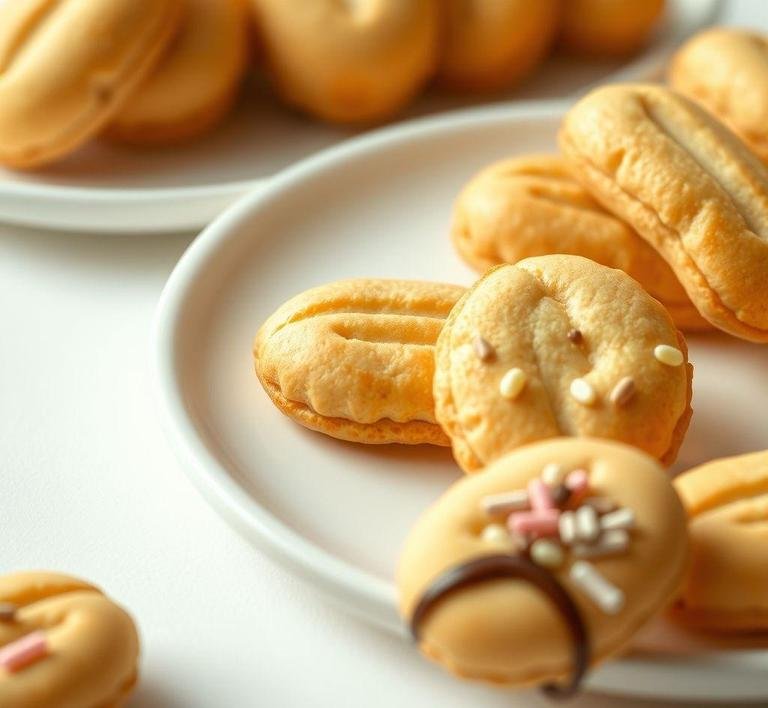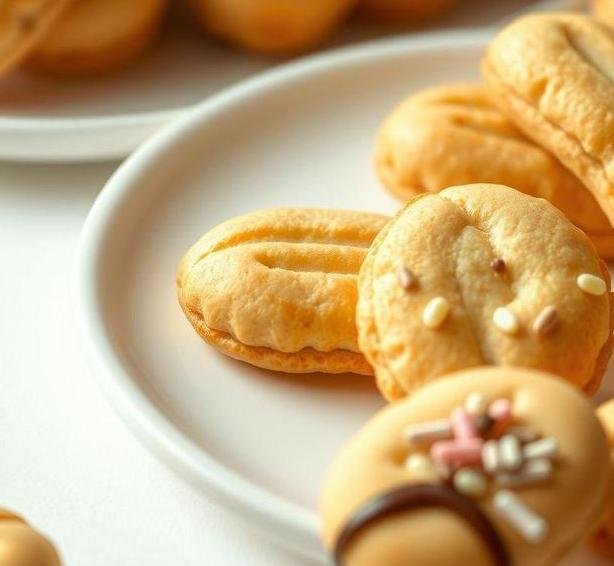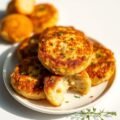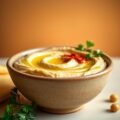Mary Berry’s Viennese Finger Biscuits are a quintessential classic in British baking, beloved for their delicate, buttery crumb and elegantly simple design. Originating from Vienna, these biscuits embody the finesse of European patisserie – a perfect marriage of buttery richness and melt-in-the-mouth texture, with a subtle sweetness that never overwhelms.
The defining characteristic of these biscuits is their slender, finger-like shape, usually piped from a soft, buttery dough. Once baked, they boast a crisp exterior that gives way to a tender interior. Traditionally, these biscuits are finished with a drizzle or dip in dark chocolate, adding a layer of bittersweet sophistication that complements the richness of the biscuit itself.
What makes Mary Berry’s version special is her signature balance of simplicity and precision. She strips the recipe down to essentials without sacrificing flavor or elegance, making it accessible for home bakers while still delivering that bakery-quality finish. These biscuits are perfect for teatime, a fancy gathering, or even as a thoughtful homemade gift. They pair beautifully with a strong cup of tea or coffee, offering a moment of indulgence in every bite.
Mary Berry’s Viennese Finger Biscuits Recipe
Ingredients Needed

To create Mary Berry’s Viennese Finger Biscuits, the ingredient list is beautifully simple, reflecting the essence of classic baking. Each component plays a critical role in achieving that signature buttery, crisp, and tender texture.
- Unsalted Butter (softened) – The star of the show. Butter provides the rich flavor and contributes to the delicate crumb. Using unsalted butter allows control over the saltiness.
- Icing Sugar (confectioners’ sugar) – This finely ground sugar helps create a smooth, tender dough while adding a subtle sweetness.
- Plain Flour (all-purpose flour) – The base structure of the biscuit. It needs to be sifted to avoid lumps and ensure a light texture.
- Cornflour (cornstarch) – This is the secret weapon in many biscuit recipes, adding softness and preventing toughness by reducing gluten formation.
- Egg Yolks – Adds richness and helps bind the dough together without making it too wet.
- Vanilla Extract – A touch of vanilla brings warmth and depth to the flavor.
- Dark Chocolate – For dipping or drizzling on top, adding a sophisticated contrast to the buttery biscuit.
These ingredients, though minimal, are essential. The magic lies in the quality and balance – fresh butter, pure vanilla, and finely sifted flours all contribute to the perfect Viennese Finger.
Equipment Needed
To make Mary Berry’s Viennese Finger Biscuits just right, having the proper equipment will make the process smoother and the final results more professional:
- Mixing Bowls – A large one for combining ingredients and a smaller one if needed for melting chocolate.
- Electric Mixer or Stand Mixer – Helpful for creaming butter and sugar to achieve a light, fluffy texture, though it can be done by hand with patience.
- Sieve (Sifter) – To sift flour and cornflour, ensuring no lumps and a fine, light dough.
- Piping Bag with a Star Nozzle (around 1 cm diameter) – Essential for shaping the biscuits into their iconic finger form with delicate ridges.
- Baking Sheets (lined with parchment paper) – A non-stick surface is important to prevent biscuits from sticking and to allow easy transfer.
- Spatula – For folding ingredients and scraping bowls clean.
- Cooling Rack – Allows the biscuits to cool evenly and maintain their crispness.
- Small Bowl and Microwave or Double Boiler – For melting the dark chocolate safely without burning.
Having these tools on hand makes the process enjoyable and ensures that each biscuit is piped and baked to perfection.
Instructions To Make Mary Berry’s Viennese Finger Biscuits
Now, the moment of creation! Mary Berry’s method is straightforward but demands attention to detail to get that perfect texture and shape.
-
Preparation:
Preheat your oven to 190°C (375°F/Gas Mark 5). Line two baking sheets with parchment paper to prevent sticking and make cleanup easier.
-
Cream Butter and Icing Sugar:
In a mixing bowl, beat the softened butter and icing sugar together until pale, light, and fluffy. This step aerates the mixture, critical for a light biscuit.
-
Add Egg Yolks and Vanilla:
Beat in the egg yolks, one at a time, ensuring each is fully incorporated before adding the next. Add a teaspoon of vanilla extract to infuse gentle aromatic flavor.
-
Sift Dry Ingredients:
Sift the plain flour and cornflour together to eliminate lumps and mix well. Gradually fold this mixture into the butter mixture with a spatula, blending carefully to keep the dough soft but manageable. The dough should be soft but firm enough to pipe.
-
Pipe the Biscuits:
Fill a piping bag fitted with a large star nozzle with the dough. Pipe 5-6 cm long finger shapes onto the prepared baking sheets, leaving enough space between each to allow for slight spreading.
-
Bake:
Place the trays in the preheated oven and bake for about 10-12 minutes or until the biscuits are just starting to turn golden at the edges. They should still be pale on top.
-
Cool:
Remove from the oven and allow the biscuits to cool on the baking sheets for a few minutes before transferring them to a wire rack to cool completely.
-
Decorate with Chocolate:
Melt the dark chocolate gently in a bowl over simmering water or in short bursts in the microwave. Dip one end of each biscuit into the chocolate or drizzle it over the top using a spoon. Place the biscuits on parchment paper again to let the chocolate set completely.
Tips And Tricks
- Butter Temperature: Make sure the butter is soft but not melting. If it’s too cold, you won’t get a smooth cream; too warm, and the dough will be too soft to pipe neatly.
- Sifting Is Key: Don’t skip sifting the flour and cornflour. It keeps the dough light and ensures a tender biscuit.
- Piping Practice: If you’re new to piping, practice on a spare sheet first to get a feel for the pressure and flow needed to make uniform fingers.
- Oven Watch: Keep an eye on the biscuits towards the end of baking – they should remain pale with slight golden edges, not browned all over.
- Chocolate Quality: Use good-quality dark chocolate with around 70% cocoa for the best flavor contrast.
- Storage: Store these biscuits in an airtight tin to keep them crisp. They stay fresh for up to a week.
- Variations: For a festive twist, try sprinkling finely chopped nuts or edible glitter on the chocolate before it sets.
Mary Berry’s Viennese Finger Biscuits are a timeless treat that showcases the beauty of classic baking – minimal ingredients, simple techniques, and elegant results. Their delicate crumb, buttery richness, and chocolate finish make them irresistible accompaniments to tea or coffee. With some basic equipment and a bit of patience, any home baker can create these elegant finger-shaped biscuits that feel as special as those from a high-end patisserie.
Baking these biscuits isn’t just about the final product; it’s about enjoying the process, savoring the aromas, and relishing the satisfaction that comes from creating something truly classic and delicious with your own hands. Whether you’re baking for a cozy afternoon, a special event, or to share with loved ones, Mary Berry’s Viennese Finger Biscuits never fail to impress and delight.
Easy Recipe Variations For Mary Berry’s Viennese Finger Biscuits

Mary Berry’s Viennese Finger Biscuits are a classic delight-light, buttery, and elegantly simple. But what makes them truly exciting is how wonderfully versatile the basic recipe is. Starting with Mary’s fundamental blend of softened butter, icing sugar, plain flour, and cornflour, you can easily twist the flavor and texture to suit different occasions or moods.
1. Chocolate-Dipped Viennese Fingers: One of the most popular variations is to dip one end of each biscuit into melted dark, milk, or white chocolate. For an extra touch of luxury, sprinkle finely chopped nuts, edible gold dust, or tiny pieces of freeze-dried raspberries onto the wet chocolate before it sets. This not only adds a beautiful contrast in flavor but also creates a sophisticated finish that feels special at teatime.
2. Citrus Zest Twist: Adding a teaspoon of finely grated lemon or orange zest to the dough introduces a fresh, zingy note that lifts the buttery richness. This citrus variation pairs beautifully with afternoon tea, especially when served alongside a fragrant Earl Grey or a fresh herbal infusion.
3. Almond or Hazelnut Flour: Substitute a quarter of the plain flour with finely ground almonds or hazelnuts. This nutty variation adds subtle texture and a richer flavor profile, making the biscuits taste slightly more decadent and perfect for gifting in a decorative tin.
4. Flavored Icing Sugar: Infuse the icing sugar with flavors like vanilla bean seeds or a hint of cinnamon before mixing. This subtle change can add warmth and complexity to each bite, perfect for colder months or festive occasions.
5. Jam Sandwich Fingers: After baking and cooling the biscuits, sandwich two fingers together with a thin layer of raspberry or strawberry jam. This makes the biscuits more indulgent, reminiscent of classic jammy cookies, but still maintaining the crisp, delicate finger shape.
Each variation keeps the core elements that make Mary’s Viennese Fingers so beloved-delicate crunch and buttery softness-while offering a personalized touch to suit your taste buds or party themes. Experimenting with these small twists can turn a familiar recipe into something uniquely yours.
Storing Leftovers
Viennese Finger Biscuits are delightfully crisp when fresh, but their delicate texture means proper storage is essential to keep them from going soft or stale. The good news is, with a few simple steps, you can enjoy them days after baking without losing their iconic snap.
1. Airtight Containers Are Key: Once your biscuits have completely cooled, place them carefully in an airtight container. Glass or metal tins with tight-sealing lids work best. This prevents moisture from creeping in, which can make the biscuits soggy.
2. Layering with Parchment Paper: If you’ve baked a large batch, place sheets of parchment or wax paper between layers to avoid sticking or crumbling. This helps maintain the biscuits’ shape and presentation, especially if you plan to serve them later.
3. Room Temperature Storage: Store your container in a cool, dry place-away from direct sunlight or heat sources. Typically, Viennese Fingers keep their texture well for up to a week when stored this way.
4. Freezing for Longer Storage: If you want to keep your biscuits for longer than a week, freezing is a great option. Place them in a freezer-safe airtight container or a zip-lock bag with parchment paper between layers. When you’re ready to enjoy them, thaw at room temperature for about 30 minutes. They’ll regain their lovely buttery crunch almost as if freshly baked.
5. Avoid Refrigeration: Though it might seem logical, refrigeration is not ideal for these biscuits, as the moisture inside the fridge can cause them to lose their crispness quickly.
By taking these simple storage precautions, your Viennese Finger Biscuits will maintain their melt-in-the-mouth charm and be ready to delight whenever the craving strikes.
What To Eat With Mary Berry’s Viennese Finger Biscuits?
These biscuits are famously elegant and perfect as a teatime treat, but their mild buttery flavor and delicate texture make them surprisingly versatile in how you enjoy them.
1. Classic Tea or Coffee: The quintessential pairing is a cup of freshly brewed tea-English Breakfast, Earl Grey, or Darjeeling all complement the biscuits beautifully. The slight bitterness of the tea balances the buttery sweetness of the fingers, creating a perfect harmony of flavors. For coffee lovers, a mild filter coffee or a smooth latte can also enhance the biscuit’s rich notes.
2. With Fresh Berries and Cream: For a more indulgent serving, arrange your Viennese Fingers alongside a bowl of fresh raspberries, strawberries, or blueberries, and a dollop of softly whipped cream. The tartness of the berries and the creaminess of the topping add layers of texture and taste, turning a simple biscuit into a light, sophisticated dessert.
3. Ice Cream Companion: These biscuits can be crushed lightly and sprinkled over vanilla or chocolate ice cream as a crunchy topping. Alternatively, serve whole fingers on the side of an ice cream sundae to add that buttery snap between spoonfuls.
4. Chocolate Fondue Dipper: If you’re hosting a party, Viennese Fingers make delightful dippers for chocolate fondue. Their firm yet tender texture holds up beautifully when dipped, and their buttery taste is enhanced by the warm, gooey chocolate.
5. Dessert Platter Addition: Incorporate these biscuits into a dessert platter featuring cheeses, nuts, dried fruits, and other sweet treats. Their subtle sweetness and texture offer a nice contrast to stronger flavors, making them a lovely palate cleanser or accompaniment.
No matter how you choose to serve them, Mary Berry’s Viennese Finger Biscuits elevate any snack or dessert moment with their timeless charm and delicate taste.
Conclusion
Mary Berry’s Viennese Finger Biscuits are much more than just a simple biscuit-they’re a testament to the elegance of classic baking. With their buttery crumb, tender texture, and subtle sweetness, these biscuits have an irresistible charm that makes them perfect for everyday teatime or special occasions. The beauty lies in their simplicity, yet they offer so much room for creativity, whether through easy flavor variations or pairing ideas.
Proper storage ensures that you can savor their delicate crunch long after baking, and their compatibility with a range of drinks and accompaniments makes them a versatile kitchen staple. Whether dipped in chocolate, infused with citrus zest, or served alongside fresh cream and berries, these biscuits never fail to impress.
In the world of homemade treats, Mary Berry’s Viennese Finger Biscuits hold a special place-a delicate, buttery hug wrapped in golden perfection. So next time you’re in the mood to bake something classic yet customizable, these biscuits should definitely be your go-to recipe.
FAQs
What Are Mary Berry’s Viennese Finger Biscuits Made Of?
Mary Berry’s Viennese finger biscuits are traditionally made with simple ingredients like butter, icing sugar, plain flour, cornflour, and vanilla extract. The recipe is straightforward and results in delicate, crumbly biscuits. The dough is piped into long fingers, which gives these biscuits their characteristic shape.
Can I Make Mary Berry’s Viennese Finger Biscuits In Advance?
Yes, you can make these biscuits ahead of time. Once baked and cooled, they can be stored in an airtight container for up to a week. If you want to keep them for longer, you can freeze the biscuits for up to a month. Just make sure to let them cool completely before freezing, and defrost them at room temperature before serving.
Why Are Mary Berry’s Viennese Finger Biscuits So Crumbly?
The crumbly texture of Mary Berry’s Viennese finger biscuits is a result of the combination of butter, icing sugar, and cornflour. The high butter content creates a rich, melt-in-the-mouth texture, while the cornflour helps to tenderize the dough, giving the biscuits their light, delicate structure.


